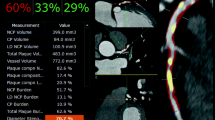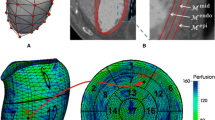Abstract
Background
Coronary computed tomography angiography (CCTA) is a well-established non-invasive diagnostic test for the assessment of coronary artery diseases (CAD). CCTA not only provides information on luminal stenosis but also permits non-invasive assessment and quantitative measurement of stenosis based on radiomics.
Purpose
This study is aimed to develop and validate a CT-based radiomics machine learning for predicting chronic myocardial ischemia (MIS).
Methods
CCTA and SPECT-myocardial perfusion imaging (MPI) of 154 patients with CAD were retrospectively analyzed and 94 patients were diagnosed with MIS. The patients were randomly divided into two sets: training (n = 107) and test (n = 47). Features were extracted for each CCTA cross-sectional image to identify myocardial segments. Multivariate logistic regression was used to establish a radiomics signature after feature dimension reduction. Finally, the radiomics nomogram was built based on a predictive model of MIS which in turn was constructed by machine learning combined with the clinically related factors. We then validated the model using data from 49 CAD patients and included 18 MIS patients from another medical center. The receiver operating characteristic curve evaluated the diagnostic accuracy of the nomogram based on the training set and was validated by the test and validation set. Decision curve analysis (DCA) was used to validate the clinical practicability of the nomogram.
Results
The accuracy of the nomogram for the prediction of MIS in the training, test and validation sets was 0.839, 0.832, and 0.816, respectively. The diagnosis accuracy of the nomogram, signature, and vascular stenosis were 0.824, 0.736 and 0.708, respectively. A significant difference in the number of patients with MIS between the high and low-risk groups was identified based on the nomogram (P < .05). The DCA curve demonstrated that the nomogram was clinically feasible.
Conclusion
The radiomics nomogram constructed based on the image of CCTA act as a non-invasive tool for predicting MIS that helps to identify high-risk patients with coronary artery disease.







Similar content being viewed by others
References
Shay CM, Ning H, Daniels SR, et al. Status of cardiovascular health in US adolescents: Prevalence estimates from the National Health and Nutrition Examination Surveys (NHANES) 2005–2010. Circulation 2013;127:1369-76.
Montalescot G, Sedltem U, Achenbech S, et al. ESC guidelines on the management of stable coronary artery disease: The task Force on the management of stable coronary artery disease of the European Society of Cardiology. Eur Heart 2013;2013:2949-3003.
Patel MR, Dehmer GJ, Hirshfeld JW, et al. ACCF/SCAI/STS/AATS/AHA/ASNC/HFSA/SCCT 2012 Appropriate use criteria for coronary revascularization focused update: a report of the American College of Cardiology Foundation Appropriate Use Criteria Task Force, Society for Cardiovascular Angiography and Interventions, Society of Thoracic Surgeons, American Association for Thoracic Surgery, American Heart Association, American Society of Nuclear Cardiology, and the Society of Cardiovascular Computed Tomography. J Am Coll Cardiol 2012;59:1336.
Budoff MJ, Li D, Kazerooni EA, et al. Diagnostic accuracy of noninvasive 64-row computed tomographic coronary angiography (CCTA) compared with myocardial perfusion imaging (MPI): The PICTURE study. A prospective multicenter trial. Acad Radiol 2017;1:22-9.
von Ballmoos MW, Haring B, Juillerat P, et al. Metaanalysis: diagnostic performance of low-radiation-dose coronary computed tomography angiography. Ann Intern Med 2011;154:413-20.
Hacker M, Jakobs T, Hack N, et al. Sixty-four slice spiral CT angiography does not predict the functional relevance of coronary artery stenoses in patients with stable angina. Eur J Nucl Med Mol Imaging 2007;34:4-10.
Meijboom WB, Van Mieghem CA, Van Pelt N, et al. Comprehensive assessment of coronary artery stenoses: Computed tomography coronary angiography versus conventional coronary angiography and correlation with fractional flow reserve in patients with stable angina. J Am Coll Cardiol 2008;52:636-43.
Hulten E, Pickett C, Bittencourt MS, et al. Outcomes after coronary computed tomography angiography in the emergency department: a systematic review and meta-analysis of randomized, controlled trials. J Am Coll Cardiol 2013;61:880-92.
Ko SM, Song MG, Chee HK, et al. Diagnostic performance of dual-energy CTstress myocardial perfusion imaging: Direct comparison with cardiovascular MRI. Am J Roentgenol 2014;203:605-13.
Yoon YE, Choi JH, Kim JH, et al. Noninvasive diagnosis of ischemia-causing coronary stenosis using CT angiography: Diagnostic value of transluminal attenuation gradient and fractional flow reserve computed from coronary CT angiography compared to invasively measured fractional flow reserve. JACC Cardiovasc Imaging 2012;5:1088-96.
Mangold S, Gatidis S, Luz O, et al. Single-source dual-energy computed tomography: Use of monoenergetic extrapolation for a reduction of metal artifacts. Invest Radiol 2014;49:788-93.
La Grutta L, Toia P, Maffei E, et al. Infarct characterization using CT. Cardiovasc Diagn Ther 2017;7:171-88.
Yip SS, Aerts HJ. Applications and limitations of radiomics. Phys Med Biol 2016;61:R150-66.
De Albuquerque M, Anjos LG, Maia Tavares de Andrade HM, et al. MRI texture analysis reveals deep gray nuclei damage in amyotrophic lateral sclerosis. J Neuroimaging 2016;26:201-206.
Kolossváry M, Kellermayer M, Merkely B, et al. Cardiac computed tomography radiomics: A comprehensive review on radiomic techniques. J Thorac Imaging 2018;33:26-34.
Larroza A, Materka A, López-Lereu M, et al. Differentiation between acute and chronic myocardial infarction by means of texture analysis of late gadolinium enhancement and cine cardiac magnetic resonance imaging. Eur J Radiol 2017;92:78-83.
Schofield R, Ganeshan B, Kozor R, et al. CMR myocardial texture analysis tracks different etiologies of left ventricular hypertrophy. J Cardiovasc Magn Reson 2016;18:1-2.
Baeßler B, Mannil M, Maintz D, et al. Texture analysis and machine learning of non-contrast T1-weighted MR images in patients with hypertrophic cardiomyopathy-Preliminary results. Eur J Radiol 2018;102:61-7.
Baessler B, Luecke C, Lurz J. Cardiac MRI texture analysis of T1 and T2 maps in patients with infarc tlike acute myocarditis. Radiology 2018;289:357-65.
Amano Y, Suzuki Y, Yanagisawa F, et al. Relationship between extension or texture features of late gadolinium enhancement and ventricular tachyarrhythmias in hypertrophic cardiomyopathy. Biomed Res Int 2018;2018:4092469.
Liang C, Huang Y, He L, et al. The development and validation of a CT-based radiomics signature for the preoperative discrimination of stage I–II and stage III–IV colorectal cancer. Oncotarget 2016;7:31401-12.
Huang YQ, Liang CH, He L, et al. Development and validation of a radiomics nomogram for preoperative prediction of lymph node metastasis in colorectal cancer. J Clin Oncol 2016;34:2157-64.
Fihn SD, Gardin JM, Abrams J, et al. 2012 ACCF/AHA/ACP/ AATS/PCNA/SCAI/STS guideline for the diagnosis and management of patients with stable ischemic heart disease: a report of the American College of Cardiology Foundation/American Heart Association task force on practice guidelines, and the American College of Physicians, American Association for Thoracic Surgery, Preventive Cardiovascular Nurses Association, Society for Cardiovascular Angiography and Interventions, and Society of Thoracic Surgeons. Circulation 2012;126:e354-471.
Gensini GG. A more meaningful scoring system for determining the severity of coronary heart disease. Am J Cardiol 1983;51:606.
Sun R, Limkin EJ, Vakalopoulou M, et al. A radiomics approach to assess tumour-infiltrating CD8 cells and response to anti-PD-1 or anti-PD-L1 immunotherapy: An imaging biomarker, retrospective multicohort study. Lancet Oncol 2018;19:1180-91.
Thawani R, McLane M, Beig N, et al. Radiomics and radiogenomics in lung cancer: A review for the clinician. Lung Cancer 2018;115:34-41.
Shu Z, Fang S, Ding Z, et al. MRI-based radiomics nomogram to detect primary rectal cancer with synchronous liver metastases. Sci Rep 2019;9:3374.
Wu J, Aguilera T, Shultz D, et al. Early-stage non-small cell lung cancer: Quantitative imaging characteristics of 18F fluorodeoxyglucose PET/CT allow prediction of distant metastasis. Radiology 2016;281:270-8.
Mukaka MM. Statistics corner: A guide to appropriate use of correlation coefficient in medical research. Malawi Med J 2012;24:69-71.
Unler A, Murat A, Chinnam RB. mr2PSO: A maximum relevance minimum redundancy feature selection method based on swarm intelligence for support vector machine classification. Inf Sci 2011;181:4625-41.
Wu Y, Xu L, Yang P, et al. Survival prediction in high-grade osteosarcoma using radiomics of diagnostic computed tomography. EbioMedicine 2018;34:27-34.
Parmar C, Grossmann P, Rietveld D, et al. Radiomic machine-learning classifiers for prognostic biomarkers of head and neck cancer. Front Oncol 2015;5:272.
O’Brien RM. A caution regarding rules of thumb for variance inflation factors. Qual Quant 2007;41:673-90.
Vickers AJ, Van Calster B, Steyerberg EW. Net benefit approaches to the evaluation of prediction models, molecular markers, and diagnostic tests. BMJ 2016;352:i6.
Schuijf JD, Wijns W, Jukema JW, et al. Relationship between noninvasive coronary angiography with multi-slice computed tomography and myocardial perfusion imaging. J Am Coll Cardiol 2006;48:2508-14.
Ozaki Y, Okumura M, Ismail TF, et al. Coronary CT angiographic characteristics of culprit lesions in acute coronary syndromes not related to plaque rupture as defined by optical coherence tomography and angioscopy. Eur Heart J 2011;32:2814-23.
Gaemperli O, Scbepis T, Valenta I, et al. Cardiac image fusion from stand-alone SPECT and CT clinical experience. J Nucl Med 2007;48:696-703.
Park HB, Heo R, Hartaigh B, et al. Atherosclerotic plaque characteristics by CT angiography identify coronary lesions that cause ischemia: A direct comparison to fractional flow reserve. JACC Cardiovasc Imaging 2015;8:1-10.
Gaur S, Ovrehus KA, Dey D, et al. Coronary plaque quantification and fractional flow reserve by coronary computed tomography angiography identify ischaemia-causing lesions. Eur Heart J 2016;37:1220-7.
Nakahara T, Iwabuchi Y, Murakami K. Diagnostic performance of 3D bull’s eye display of SPECT and coronary CTA fusion. Cardiovasc Imaging 2016;9:703-11.
Leipsic J, Weir-McCall J, Blanke P. FFRCT for complex coronary artery disease treatment planning: new opportunities. Interv Cardiol 2018;13:126-8.
Delgado Sánchez-Gracián C, Oca Pernas R, Trinidad López C, et al. Quantitative myocardial perfusion with stress dual-energy CT: Iodine concentration differences between normal and ischemic or necrotic myocardium, initial experience. Eur Radiol 2016;26:3199-207.
Antunes S, Esposito A, Palmisanov A, et al. Characterization of normal and scarred myocardium based on texture analysis of cardiac computed tomography images. Conf Proc IEEE Eng Med Biol Soc 2016;2016:4161-4.
Mannil M, von Spiczak J, Manka R, et al. Texture analysis and machine learning for detecting myocardial infarction in Noncontrast low-dose computed tomography: Unveiling the invisible. Invest. Radiol 2018;53:338-43.
Hinzpeter R, Wagner MW, Wurnig MC, et al. Texture analysis of acute myocardial infarction with CT: First experience study. PLoS ONE 2017;12:e0186876.
Damini D, Sara G, Kristian AO, et al. Integrated prediction of lesion-specific ischaemia from quantitative coronary CT angiography using machine learning: A multicentre study. Eur Radiol 2018;28:2655-64.
Disclosures
None.
Author information
Authors and Affiliations
Corresponding authors
Additional information
Publisher's Note
Springer Nature remains neutral with regard to jurisdictional claims in published maps and institutional affiliations.
The authors of this article have provided a PowerPoint file, available for download at SpringerLink, which summarizes the contents of the paper and is free for re-use at meetings and presentations. Search for the article DOI on SpringerLink.com.
Electronic supplementary material
Below is the link to the electronic supplementary material.
Rights and permissions
About this article
Cite this article
Shu, ZY., Cui, SJ., Zhang, YQ. et al. Predicting Chronic Myocardial Ischemia Using CCTA-Based Radiomics Machine Learning Nomogram. J. Nucl. Cardiol. 29, 262–274 (2022). https://doi.org/10.1007/s12350-020-02204-2
Received:
Accepted:
Published:
Issue Date:
DOI: https://doi.org/10.1007/s12350-020-02204-2




